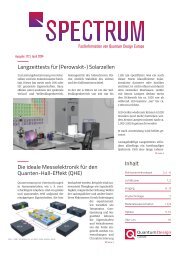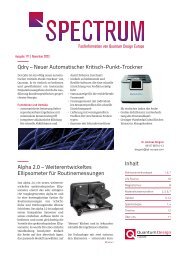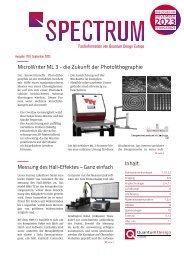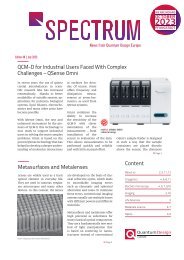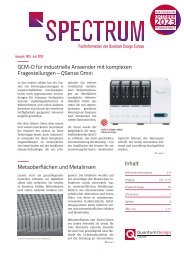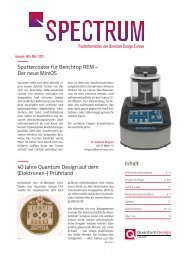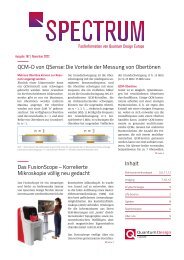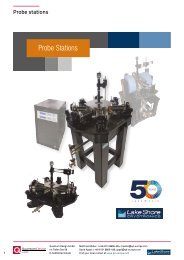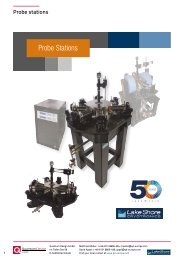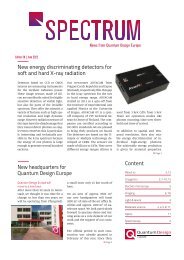Spectrum E39
Create successful ePaper yourself
Turn your PDF publications into a flip-book with our unique Google optimized e-Paper software.
Optics<br />
extension, a 12 mm block filter and<br />
a 21 mm etalon. To adjust the wavelength,<br />
the etalon is heated with 1.5<br />
A at 5 V via a power supply unit. An<br />
aperture system ensures stray light<br />
reduction and provides for high contrast.<br />
Fig. 4 shows the setup for detailed<br />
studies of activity regions in Hα<br />
light on a refractor with 102 mm<br />
aperture and 714 mm focal length.<br />
The imaging is done using a monochrome<br />
astro camera, in which a<br />
Sony IMX174LLJ CMOS chip is installed<br />
and that delivers up to 120<br />
frames per second. This allows air<br />
turbulence to be "frozen" to a large<br />
extent. Due to their higher resolution,<br />
monochrome cameras are preferred<br />
over color cameras.<br />
Investigations in the light of the Hα<br />
line show changes in prominences,<br />
filaments, and flares over time scales<br />
of just a few minutes, while noticeable<br />
structural changes in photospheric<br />
phenomena (e.g. sunspots)<br />
cannot be be detected before several<br />
hours have elapsed. For this reason,<br />
Hα observations are of particular interest.<br />
After more than 6 years of regular<br />
use, reduced contrast was observed<br />
in the imaging of activity regions of<br />
the chromosphere: Prominences on<br />
the solar disk, recognizable as dark<br />
filaments, were barely visible (see<br />
Fig. 5 above).<br />
The reason for this was found quickly:<br />
The manufacturer's recommendation<br />
to put a UV-IR filter in front of<br />
the QUARK filter in telescopes with<br />
an aperture of 80 mm and larger had<br />
not been not complied with consistently.<br />
We now hoped that the etalon<br />
had not been damaged. Starting<br />
from the assumption that only the<br />
Fig. 5: An Hα image before and after replacement of<br />
the block filter In the bottom picture, the numerous<br />
appearing structures characterizing the solar activity<br />
are clearly visible.<br />
block filter had been affected (see<br />
Fig. 6), we ordered a bandpass filter<br />
656FS02-12.5 from Quantum Design.<br />
Fig. 6: The sunlight enters the filter system of the Hα<br />
QUARK eyepiece filter via this 12 mm bandpass filter<br />
(block filter), thus providing for dramatically reduced<br />
heat generation.<br />
With a CWL of 656.3 nm +0.2/-0 nm, an<br />
HWB of 1.0 nm ±0.2 nm at a transmission<br />
of at least 45% and a blocking of<br />
at least OD4, this filter meets the requirements<br />
for correct operation of<br />
the eyepiece filter. After this simple<br />
retrofitting measure, we noted with<br />
relief that the contrast in the image<br />
was as good again as it had been in<br />
the early years (see Fig. 5 below). Now,<br />
a permanently installed UV/IR filter<br />
in the optical deflection system prevents<br />
premature deterioration of the<br />
eyepiece filter system.<br />
■ Dr. Gerhard Hirth<br />
■ Director of Meckesheim<br />
Observatory<br />
■ https://www.sternwartemeckesheim.de<br />
For more information, please visit<br />
our website.<br />
www.qd-europe.com<br />
Fig. 4: Optical configuration for spatial and kinematic studies of solar chromosphere phenomena. Via an optical<br />
deflection system, sunlight from the refractor is guided through the Daystar Hα QUARK eyepiece filter. Here,<br />
imaging is done using an astro camera connected to a notebook.<br />
Please contact us<br />
optics@qd-europe.com<br />
5 <strong>Spectrum</strong>, International edition 39| December 2022




